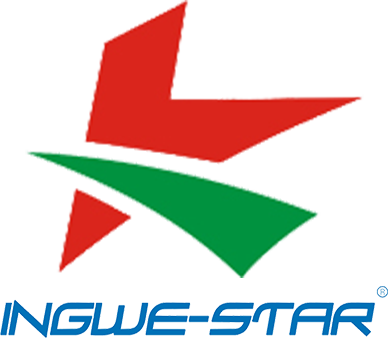Designing Your Custom Backlit Sign: Materials, Dimensions, and Brand Considerations
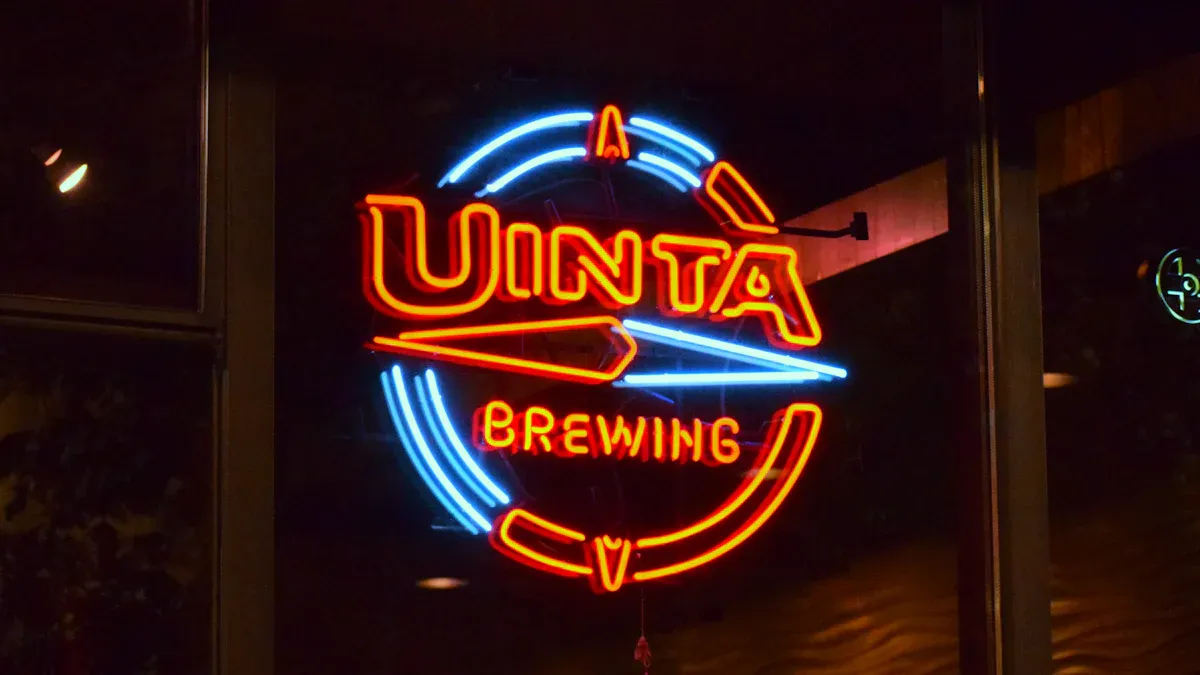
A custom backlit sign helps your business get noticed. It stands out during the day and at night. You get better visibility and a professional look. This happens when you pick good materials and the right size. Backlit signs use light to show your message. People can see it even when it is dark. This helps you get more attention. It also helps people remember your brand.
Feature | Traditional Signage | |
|---|---|---|
Visibility | Easy to see in any light | Hard to see when it is dark |
Aesthetic Appeal | Looks more attractive | Simple design |
Attention Attraction | Gets people’s attention | Can blend in with other things |
Brand Recall | Helps people remember your brand | Not as good for memory |
Professionalism | Shows your business is professional | May not look as professional |
Backlit signs help you reach more people. They keep your brand strong all the time. Picking the right sign shows what your business cares about. It helps people remember you for a long time.
Key Takeaways
Custom backlit signs help people see your business. They make your business easy to notice all day and night.
Pick materials like acrylic or polycarbonate. These last a long time and spread light well.
Make your sign big enough so people can see it far away. Use the 1-inch-to-10-feet rule for size.
Add your brand’s logo and colors. This helps people remember and trust your brand.
Get help from sign professionals. They make sure your sign looks good and fits your business.
Backlit Signs Overview
What Are Backlit Signs
Backlit signs are found in lots of places. Businesses use them to stand out. These signs have a light behind the sign face. The light shines through the material. This makes your message easy to see. People can read it at night or in dark spots. You see backlit signs in shopping centers. They are also in restaurants and office buildings. These signs grab attention. They make your business look modern.
There are different illuminated signs. The most common are backlit signs and edge-lit signs. Here is a quick comparison:
Type of Sign | Description | Common Uses in Commercial Settings |
|---|---|---|
Backlit Signs | Signs with a light source behind the face, enhancing visibility. | Ideal for attracting attention from passersby. |
Edge-Lit Signs | Signs that use LED lights along the edges to illuminate the sign face. | Used for logos and branding in business settings. |
Edge-lit signs use LED lights on the edges. This makes a glowing outline. It works well for logos or branding. Both types help your business stand out. Each one has its own style and effect.
Benefits for Businesses
Backlit signs give your business many benefits. You get better visibility at night or in low light. The glowing sign can be seen from far away. This helps you get more customers, even after dark.
Illuminated signage panels catch people’s eyes in busy areas.
They are more noticeable than regular poster frames.
Retail and service businesses use them to draw in customers.
The illumination ensures your message stays clear in any lighting.
Translucent materials let the light shine through, making your sign pop.
Your business looks modern and professional too. Customers see your sign and think you care about quality. A good sign makes a strong first impression. It helps build trust. Studies show about 76% of people enter a store because the sign caught their eye.
Tip: Picking the right sign can help you get more people to visit and remember your brand.
Backlit signs and edge-lit signs help you share your message clearly. They show your business is ready to serve customers, day or night.
Materials for Custom Backlit Signs
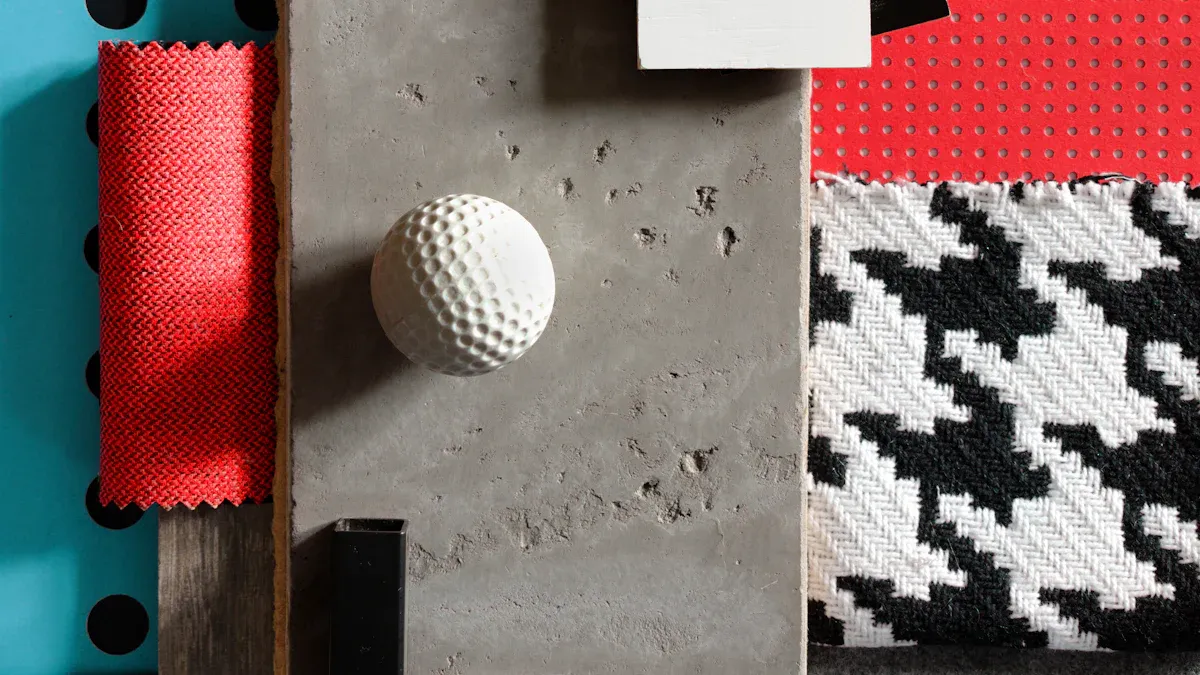
Acrylic, Polycarbonate, PVC
You need to pick the best material for your custom backlit sign. The most used materials are acrylic, polycarbonate, and PVC. Each one works well for backlit signs and edge-lit signs. The table below shows how these materials let light through and other features:
Material | Light Transmission | Diffusion Properties | Additional Features |
|---|---|---|---|
Acrylic | 92% | Excellent diffusion of LED hot spots | UV-stable, easy to fabricate |
Polycarbonate | 88% | Good diffusion of LED hot spots | More durable, better heat resistance |
PVC | 80% (approximate) | Moderate diffusion | Lightweight, cost-effective |
Acrylic spreads light the best. Your sign will look bright and smooth. Polycarbonate is strong and does not get damaged by heat. PVC is light and good for many business signs. Edge-lit signs often use acrylic or polycarbonate because they spread light well.
Material Impact
The material you choose changes how your sign looks and how long it lasts. Acrylic is light and can be shaped in many ways. It spreads light evenly, so your message is easy to see. Polycarbonate is tough. It is good for places where people might touch the sign or where weather is rough. PVC is a smart pick if you want a simple sign that does not cost much.
Here is a quick look at how each material affects appearance and how long it lasts:
Material | Appearance | Longevity | Typical Lifespan |
|---|---|---|---|
Acrylic | Versatile, lightweight, even light | Good | 5–10 years |
Polycarbonate | Strong, clear, resists impact | Excellent | 7–12 years |
PVC | Simple, matte finish, less light diffusion | Fair | 3–7 years |
Acrylic is great for custom shapes and gives a smooth look.
Polycarbonate is best for outdoor or busy places.
PVC is good for short-term or low-cost projects.
Flex face material is another choice for backlit signs. It keeps your sign bright and spreads light evenly. This material holds its shape for a long time, so your sign stays looking nice.
Cost vs. Quality
You want your sign to last and look good, but you also need to think about price. Acrylic costs more than PVC, but it lasts longer and looks better. Polycarbonate costs the most, but it is the strongest. PVC is the cheapest, but you may need to replace it sooner.
Material | Durability | Weather Resistance | Cost | Best For |
|---|---|---|---|---|
PVC | 1–3 years | Good | $ | Most commercial outdoor signs |
Acrylic | 3–5 years | Very Good | $ | Retail and illuminated signage |
Polycarbonate | 5–10 years | Excellent | $$ | Safety, industrial, or impact-prone areas |
When you think about cost and quality, remember these things:
How much energy your sign uses. LED signs save money over time.
How often you need to clean or fix your sign.
If you can save money by buying more signs at once.
If the company gives you a warranty or good help after you buy.
Tip: Pick a material that fits your business and your budget. Spending more at first can mean fewer repairs and a sign that lasts longer.
The right material helps your sign stand out. It also makes sure your backlit signs and edge-lit signs work for years. Always pick a material that matches your brand and the place you will put the sign.
Dimensions & Visibility
Sizing Factors
When you plan your sign, you need to think about where you will put it and how people will see it. The size of your sign should fit its surroundings. If your sign is too small, people may miss it. If it is too big, it might look out of place. You want your sign to stand out but not clash with nearby buildings or other signs.
Here are some important factors to consider when choosing the right size for your backlit or edge-lit signs:
Surroundings: Make sure your sign fits in with the area but does not blend in too much.
Visibility: Check if people can see your sign from different distances and angles.
Competitor Analysis: Look at what other businesses in your area are doing. This helps you match or beat the industry standard.
Lighting Effects: Think about how sunlight, streetlights, or shadows will affect your sign’s visibility.
Brand Alignment: Your sign should match your brand’s style and message.
Viewing distance plays a big role in sizing. You can use the 1-inch-to-10-feet rule. For every inch of letter height, people can read your sign from about 10 feet away. If you want your sign to be readable from 100 feet, each letter should be at least 10 inches tall. This rule helps you make sure your sign is easy to read, even in different lighting conditions.
Visibility & Readability
You want your sign to be clear and easy to read. Good signage design uses bold, simple fonts and the right letter size. Avoid fancy or thin fonts because they can be hard to read from far away. Sans-serif fonts work best for most backlit signs and edge-lit signs.
Here are some best practices for making your sign easy to read:
Best Practice | Key Factors |
|---|---|
Prioritize Legibility | - Use large, bold fonts. |
Maintain Contrast for Readability | - Choose high-contrast colors for text and background. |
Keep It Simple and Focused | - Limit text to 7-10 words. |
Choose the Right Colors | - Use your brand colors, but make sure they stand out. |
Strategic Placement for Maximum Visibility | - Place your sign where people will see it most. |
Incorporate Eye-Catching Visuals | - Use simple graphics or icons. |
Ensure Consistency with Your Branding | - Add your logo and use your brand’s fonts and colors. |
Font size and style matter a lot. Follow these steps to boost legibility:
Pick a font that is easy to read from a distance.
Stay away from ornate or thin fonts.
Use sans-serif fonts for better clarity.
You can also use this table to help choose the right font size for your sign:
Viewing Distance | Recommended Font Size |
|---|---|
10 feet | 1 inch |
50 feet | 5 inches |
100 feet | 10 inches |
Tip: Increase the space between letters if you use smaller fonts. Use extra space between lines to make your sign easier to read.
Custom Shapes
Custom shapes can make your sign unique. You do not have to stick with rectangles or squares. You can design your sign to match your logo or brand style. Custom-shaped backlit signs and edge-lit signs help your business stand out from the crowd.
You can use your brand’s colors, fonts, and logos in creative ways.
A unique shape tells your brand’s story and shows what you value.
People remember signs that look different, which helps them remember your business.
When you use custom shapes, you show customers that you care about details. This can help you earn their trust and loyalty. Creative signage design makes your business more memorable and helps you compete with others in your area.
Brand Considerations in Business Signage
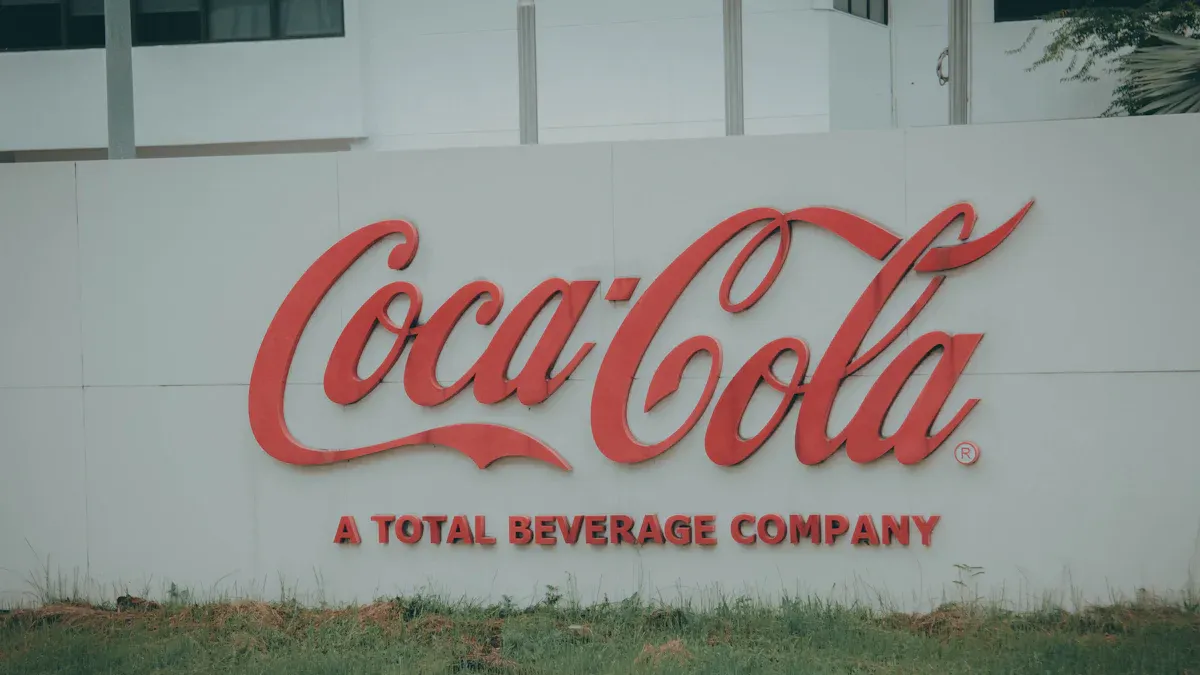
Logo & Color Integration
Begin your sign design with your logo and colors. These help people know your business. When you put your logo on backlit signs, people remember you. Using the same colors and fonts makes your brand strong. Customers see your sign and think of your business. This helps your brand stand out.
A good sign makes people remember your business.
Custom backlit signs show your special logo and colors.
Using the same design on all signs builds trust.
Picking colors is important for your sign. Red is easy to see from far away. It stands out more than other colors. If you want people to notice your sign, pick bright colors. Make sure your colors match your brand.
Font & Lighting Choices
Font style and lighting change how people read your sign. Choose a font that is easy to see from far away. Sans-serif fonts work best for outdoor signs. They look simple and clear. Bold fonts help your sign stand out. Do not use fonts that are too thick. Thick fonts can be hard to read.
Font style and size change how people see your sign.
Sans-serif fonts are best for outside signs.
Bold fonts make your sign pop, but do not overdo it.
Lighting helps people see your sign at night. Good lighting makes your message clear. Use edge-lit or backlit signs so people can read your sign from far away.
Edge-lit signs are great for logos and branding.
Consistency
Consistency keeps your brand strong everywhere. Use the same logo, colors, and fonts on every sign. Make a guide for your team. The guide should have your logo, color codes, fonts, and pictures. Use templates for signs to keep them looking the same. Teach your staff to follow these rules.
Best Practice | Description |
|---|---|
Create a Branding Guide | Make a guide with logos, colors, fonts, and images for signs. |
Use Templates | Use templates for signs so they look the same and can be changed if needed. |
Centralize Signage Design | Have one team make and check all sign designs for consistency. |
Regular Audits | Check signs often to fix any differences at different places. |
Communication and Training | Teach workers about branding rules and train them to keep signs the same. |
Set clear brand rules and let some changes happen if needed. This helps your signs look the same, even if you have many stores. Customers trust your brand when they see the same style everywhere.
Practical Tips for Custom Backlit Sign Design
Balancing Aesthetics & Function
You want your sign to look great and work well. Start by choosing clear, easy-to-read fonts with enough space between letters. High-contrast color schemes help people see your message from far away. Keep your message short so it does not overwhelm viewers. Use your brand’s colors, logo, and fonts to make your sign unique. Pick materials and finishes that match your business style. Acrylic, glass, wood, and metal all offer different looks and strengths. Place your sign at eye level for easy viewing. For edge-lit signs, make sure the design stands out but still matches your other signs. Consistent placement helps people find their way in your space.
Use simple, bold fonts and high-contrast colors.
Keep messages short and focused.
Match materials and finishes to your brand.
Position signs where people can see them easily.
Budget Planning
Planning your budget helps you avoid surprises. The cost of a custom backlit sign depends on size, materials, and design. You should also think about permits, energy use, and maintenance. Many businesses spend 1% of their revenue on signs, while larger companies may spend up to 11%. Decide how long you want your sign to last. This will help you choose the right materials and plan for future costs.
Sign Type | Average Cost Range |
|---|---|
Engineering | $700 |
Raceway-mounted channel letter sign | $1,000 - $1,200 |
Flush-mounted channel letter sign | $1,600 - $1,800 |
Custom channel letters with lighting | $4,000 - $10,000+ |
Freestanding monument or pole signs | $5,000 - $20,000+ |
Basic, non-illuminated signs | $1,000 - $3,500 |
Standard illuminated storefront signs | $3,000 - $7,000 |
Monument sign | $20,000 - $35,000 |
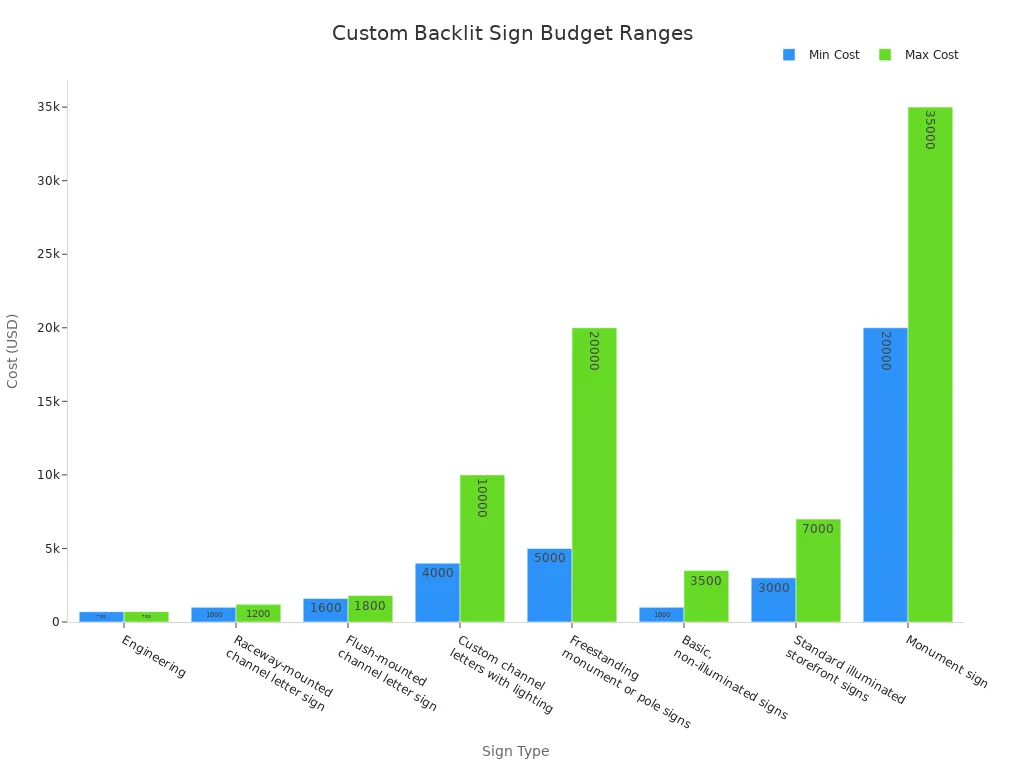
Tip: Always include ongoing costs like electricity and cleaning in your budget.
Working with Professionals
Working with sign experts makes your project easier. Ask for material samples before you decide. This helps you see how acrylic or metal will look in your space. A good designer will listen to your ideas and give advice on best practices. The design process works best when you share your vision and get feedback. For edge-lit signs, experts can help you choose the right lighting and placement. Consultations lead to better results and a sign that fits your brand.
Evidence Type | Description |
|---|---|
Material Samples | They let you explore different materials and see what matches your vision. |
Consultations | Experts guide you on design and strategy, making your project more successful. |
Note: A collaborative approach helps turn your ideas into a sign that stands out and lasts.
Choosing the right materials, size, and brand details for your custom backlit sign helps your business stand out. You should look at your location, budget, and what your customers need. The table below shows how different sign types can help your business:
Sign Type | Benefits |
|---|---|
Simple Lighted Signs | Good for basic visibility and branding. |
Digital LED Billboards | Show changing graphics for promotions and events. |
Quality signs, like edge-lit signs, last for years and keep your message clear. To get the best results, talk to a sign expert and review material samples.
Backlit signs boost visibility day and night.
Custom designs show off your logo and message.
Durable signs save money over time.
Investing in a strong sign helps people find your business and remember your brand.
FAQ
How do you clean a custom backlit sign?
Use a soft cloth and mild soap with water. Avoid harsh chemicals. Gently wipe the surface to remove dust and dirt. Dry the sign with a clean towel. Regular cleaning keeps your sign bright and easy to read.
How long does a backlit sign usually last?
Most backlit signs last 5 to 10 years. The lifespan depends on the material and how you care for it. Acrylic and polycarbonate signs last longer than PVC. LED lighting also helps your sign last longer.
Can you install a backlit sign by yourself?
You can install small signs yourself if you follow the instructions. For large or complex signs, hire a professional. Proper installation ensures safety and better performance.
What colors work best for backlit signs?
Bright colors like red, white, and yellow stand out best. High-contrast color combinations improve visibility. Use your brand colors, but make sure the text and background do not blend together.
Do backlit signs use a lot of electricity?
LED backlit signs use less electricity than older lighting types. You save money on energy bills. LED lights also last longer, so you replace them less often.
See Also
Maximize Your Brand Exposure With Acrylic Light Box Signage
Selecting The Best Acrylic Material For Light Box Signs
Creating Effective Acrylic Light Box Signs For Business Growth
